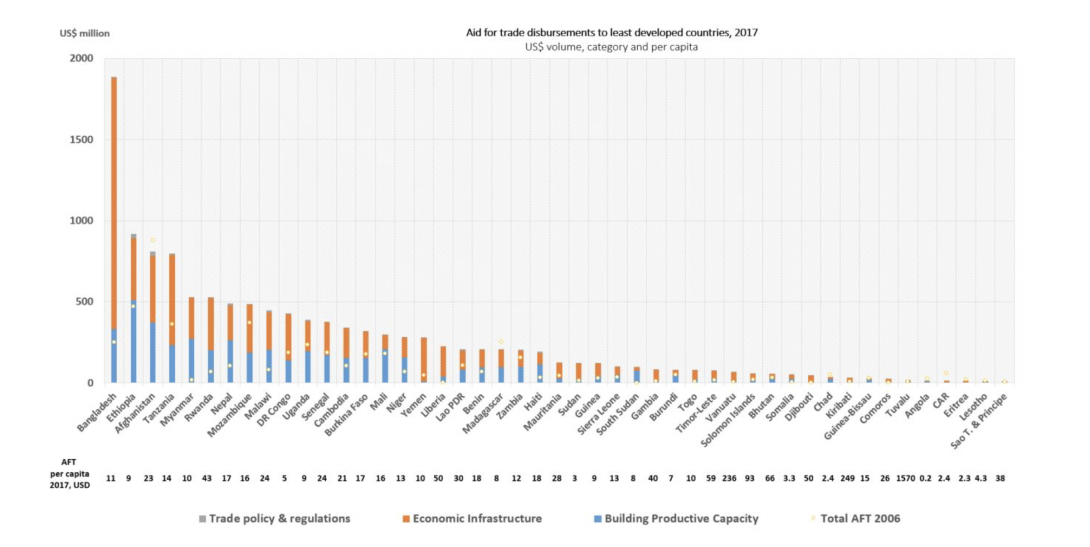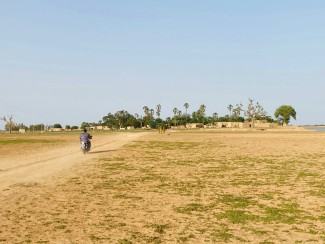|
|
|
Many least developed countries (LDCs) have made substantial development progress over the last thirty years. Five have transitioned out of LDC status, while Vanuatu and Angola are scheduled to do so in 2020-21. Ten additional countries are at different stages of meeting the graduation thresholds. However, 35 LDCs are yet to reach any of the graduation criteria.
Trade plays a vital role for the economic development of LDCs. Yet their share in world trade remains below 1%, while over half the share is split among three graduating LDCs – Angola, Bangladesh and Myanmar. Moreover, LDC merchandise exports remain concentrated in just a few products, with primary commodities accounting for over 60%.
Progress is made, but more remains to be done
LDC governments prioritise diversification of their economy and exports in their national or regional trade and development strategy, according to their responses to the 2019 joint OECD-WTO monitoring and evaluation exercise. Progress is reported, but neither uniform nor universal. Agriculture is the sector where most advances were reported, with services and industry following close behind. This concurs with the picture emerging from trade statistics, which reveals an increase in LDC export diversification over the past decade, albeit starting from a low base.
Among the host of challenges that are hampering progress in economic diversification, industrial or manufacturing capacity tops the list of LDC concerns. Most emphasize the importance of tackling infrastructure that is poorly adapted to industrialisation and export diversification. As a matter of fact, the quantity and quality of network infrastructure is a much more pronounced concern for LDCs (79%) than other developing country respondents (32%). Thus aid for trade targeting transport and network infrastructure – road, power and information and communications technology – is essential.
From the LDC responses it also clearly emerges that economic diversification is perceived not only as a gateway, but also an outcome of economic empowerment. Skills and training are instrumental in promoting economic diversification, particularly when this enables youth, women and micro-, small- and medium-sized enterprises to engage in international trade. Ninety-five percent of LDC respondents prioritise economic empowerment in their national or regional development strategies. Most also include indicators to track progress or set specific targets, which clearly shows how serious the issue is treated.
How much aid for trade?
LDC respondents attach great importance to the critical role aid for trade plays in realizing their vision for achieving the Sustainable Development Goals. Since the start of the Aid for Trade Initiative in 2006, US$105 billion in aid for trade and an additional US$12.5 billion in trade-related other official flows has been disbursed to the LDCs.
Aid for trade commitments to the LDCs reached US$18.8 billion in 2017; three times the 2002-05 baseline average, in real terms. The increase was particularly large for donor support to trade policy up 480% to US$486 million (with a US$94 million increase for trade facilitation). This is followed by a 250% increase for support to economic infrastructure (US$11.7 billion) and a 140% increase for aid to build productive capacities (US$6.5 billion).
Aid for trade disbursements to least developed countries, 2017
US$ volume, category and per capita

Source: OECD/CRS accessed 11-06-2019
The volume of projects with a trade objective rose from US$52.3 million to US$1.87 billion and now covers 28.6% of private sector projects. Although the lower middle income countries receive larger aid for trade flows (US$23.7 billion) and upper middle income countries large trade-related other official flows (US$22.6 billion), LDCs receive the highest per capita aid for trade (US$18.8).
What are the results?
Aid for trade is found to be effective both at micro and macro levels, according to a broad range of empirical trade and development studies. More specifically, the OECD found that one dollar extra invested in aid for trade generates nearly twenty additional dollars of LDC exports. Results, however, may vary considerably depending on the type of aid for trade intervention, the sector at which the support is directed, the income level and the location of the recipient country.
The 2019 monitoring exercise also reports positive aid for trade results in improving economic diversification and empowerment. Trade facilitation and agriculture are singled out as the categories where aid for trade has delivered most results, according to the LDCs. These are also the sectors that require most future finance.
What are the success factors?
Views gathered from the monitoring exercise reveal that the alignment of aid for trade support with national or regional priorities is the key factor for success. Most donors reported that weak institutional capacity is also a major constraint in successfully delivering aid for trade, while South-South providers noted that national or regional coordination may limit the success of the aid for trade support.
------------
* Aussama Bejraoui is Policy Analyst at OECD Development Cooperation Directorate. Frans Lammersen is Senior Policy Analyst at OECD Development Cooperation Directorate. Justine Lan is Economic Affairs Officer at the WTO Development Directorate.
--------
This policy series has been funded by the Australian Government through the Department of Foreign Affairs and Trade. The views expressed in this publication are the author’s alone and are not necessarily the views of the Australian Government.
If you would like to reuse any material published here, please let us know by sending an email to EIF Communications: eifcommunications@wto.org.



